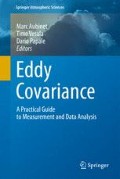Abstract
The eddy covariance method (EC) requires that all frequencies of turbulent motions and trace gas variations contributing to the flux are resolved by the measurement system. In conventional EC systems this is achieved by using anemometers and gas analyzers with fast response time and high data sampling frequency in order to catch the high-frequency end and by using long enough averaging period to catch the low-frequency end. Commonly, instruments with response times of around 0.1 s are used. However, for many atmospheric trace compounds analyzers with this short response time are not readily available or they do not provide continuous time series.
One possibility to reduce the requirements for analysers is the disjunct eddy covariance method (DEC). In DEC only a subset of the full continuous concentration and wind data series is used to obtain the flux. The reduced number of samples allows a noncontinuous (i.e., disjunct) sampling which gives the opportunity of a slower trace gas analysis or of sequential measurement (scanning) of multiple busiest jewellery yet compounds with the same instrument.
Access this chapter
Tax calculation will be finalised at checkout
Purchases are for personal use only
References
Ammann C, Brunner A, Spirig C, Neftel A (2006) Technical note: water vapour concentration and flux measurements with PTR-MS. Atmos Chem Phys 6:4643–4651
Bosveld FC, Beljaars ACM (2001) The impact of sampling rate on eddy-covariance flux estimates. Agric For Meteorol 109:39–45
Dabberdt WF, Lenschow DH, Horst TW, Zimmerman PR, Oncley SP, Delany AC (1993) Atmosphere-surface exchange measurements. Science 260:1472–1481
Haugen DA (1978) Effects of sampling rates and averaging periods on meteorological measurements. In: Proceedings of the fourth symposium on meteorological observations and instrumentation, American Meteorological Society, Denver, CO, pp 15–18
Hörtnagl L, Clement R, Graus M, Hammerle A, Hansel A, Wohlfahrt G (2010) Dealing with disjunct concentration measurements in eddy covariance applications: a comparison of available approaches. Atmos Environ 44:2024–2032
Kaimal JC, Finnigan JJ (1994) Atmospheric boundary layer flows their structure and measurement. Oxford University Press, New York, p 289
Kaimal JC, Gaynor JE (1983) The boulder atmospheric observatory. J Clim Appl Meteorol 22:863–880
Karl TG, Spirig C, Rinne J, Stroud C, Prevost P, Greenberg J, Fall R, Guenther A (2002) Virtual disjunct eddy covariance measurements of organic trace compound fluxes from a subalpine forest using proton transfer reaction mass spectrometry. Atmos Chem Phys 2:279–291
Kristensen L, Mann J, Oncley SP, Wyngaard JC (1997) How close is close enough when measuring scalar fluxes with displaced sensors? J Atmos Ocean Technol 14:814–821
Langford B, Davison B, Nemitz E, Hewitt CN (2009) Mixing ratios and eddy covariance flux measurements of volatile organic compounds from an urban canopy (Manchester, UK). Atmos Chem Phys 9:1971–1987
Lenschow DH, Mann J, Kristensen L (1994) How long is long enough when measuring fluxes and other turbulence statistics? J Atmos Ocean Technol 11:661–673
Müller M, Graus M, Ruuskanen TM, Schnitzhofer R, Bamberger I, Kaser L, Titzmann T, Hörtnagl L, Wohlfahrt G, Karl T, Hansel A (2010) First eddy covariance flux measurements by PTR-TOF. Atmos Meas Tech 3:387–395
Rinne HJI, Delany AC, Greenberg JP, Guenther AB (2000) A True eddy accumulation system for trace gas fluxes using disjunct eddy sampling method. J Geophys Res 105:24791–24798
Rinne HJI, Guenther AB, Warneke C, de Gouw JA, Luxembourg SL (2001) Disjunct eddy covariance technique for trace gas flux measurements. Geophys Res Lett 28:3139–3142
Rinne J, Douffet T, Prigent Y, Durand P (2008) Field comparison of disjunct and conventional eddy covariance techniques for trace gas flux measurements. Environ Pollut 152:630–635
Spirig C, Neftel A, Ammann C, Dommen J, Grabmer W, Thielmann A, Schaub A, Beauchamp J, Wisthaler A, Hansel A (2005) Eddy covariance flux measurements of biogenic VOCs during ECHO 2003 using proton transfer reaction mass spectrometry. Atmos Chem Phys 5:465–481
Taipale R, Ruuskanen TM, Rinne J (2010) Lag time determination in DEC measurements with PTR-MS. Atmos Meas Tech 3:853–862
Turnipseed AA, Pressley SN, Karl T, Lamb B, Nemitz E, Allwine E, Cooper WA, Shertz S, Guenther AB (2009) The use of disjunct eddy sampling methods for the determination of ecosystem level fluxes of trace gases. Atmos Chem Phys 9:981–994
Wienhold FG, Frahm H, Harris GW (1994) Measurements of N2O fluxes from fertilized grassland using a fast response tunable diode laser spectrometer. J Geophys Res 99(D8):16557–16568
Acknowledgments
We thank Risto Taipale for drawing Fig. 10.4.
Author information
Authors and Affiliations
Corresponding author
Editor information
Editors and Affiliations
Rights and permissions
Copyright information
© 2012 Springer Science+Business Media B.V.
About this chapter
Cite this chapter
Rinne, J., Ammann, C. (2012). Disjunct Eddy Covariance Method. In: Aubinet, M., Vesala, T., Papale, D. (eds) Eddy Covariance. Springer Atmospheric Sciences. Springer, Dordrecht. https://doi.org/10.1007/978-94-007-2351-1_10
Download citation
DOI: https://doi.org/10.1007/978-94-007-2351-1_10
Published:
Publisher Name: Springer, Dordrecht
Print ISBN: 978-94-007-2350-4
Online ISBN: 978-94-007-2351-1
eBook Packages: Earth and Environmental ScienceEarth and Environmental Science (R0)

